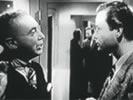Eye For Film >> Movies >> Fear In The Night (1947) Film Review
"There was danger there… I knew that. I wanted to turn and run, but I couldn’t…". In DeForest ‘Bones’ Kelley’s first major screen role, Fear In The Night, Vince Grayson (Kelley) wakes up from a dream, in which he murdered someone, with marks on his wrists and neck. He finds objects on his person which do not belong to him. He has a terrible feeling. He goes to his police detective brother-in-law Cliff Herlihy (Paul Kelly) for advice, only for his brother-in-law to suspect Grayson’s murderous actions don’t only exist in dreams…
Opening with a dream sequence that starts like a silent film, with exaggerated gestures and highly charged music, which ends with an almost surrealistic touch not too dissimilar from Salvador Dali’s REM-induced sequence in Hitchcock’s Spellbound, it’s a surprisingly rich, inventive film noir in many ways. There are clear, latent gay undertones in the depiction of the central character (who is well played by Kelley), and the moral ambiguity of whether we should like this man, who is potentially a murderer, is explored well. The plot also develops in several dark and provocative ways.

However, it is sometimes guilty of telling and not showing. There is an awful lot of exposition throughout the film. Some of this is highly unnecessary, and I suspect modern audiences might feel somewhat patronised. It feels like a hangover from the novella the film derives from; to compromise for the difficulty of conveying internal character monologues, the characters explain what they are doing, have done and are going to do, more frequently than is comfortable.
Stylistically, the film owes a huge debt to Hitchcock. From the use of mirrors to denote split identities and confusion, to the Spellbound-like dream sequence and, also, more fundamentally, the possible likeable sociopathy of the lead character, it’s highly derivative in many respects. It dulls the film’s content, and smothers the proceedings with an uninspiring veneer.
It’s a film with many positive aspects, not least in its presentation of the ambiguous nature of the central character, which is well ahead of its time. However, ultimately it feels a little too derivative in its presentation, obvious in its delivey and, in the cruelty of hindsight, straightforward to modern tastes, and will probably be of most interest to Star Trek fans who are keen to explore the career origins of one the show’s most famous actors.
Reviewed on: 21 May 2009



















